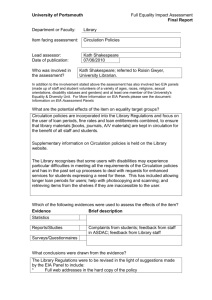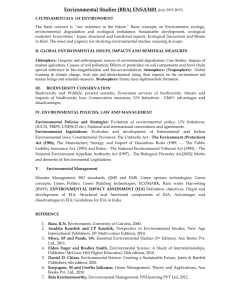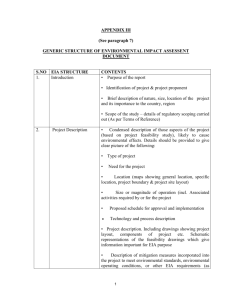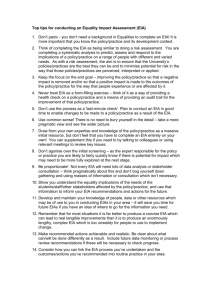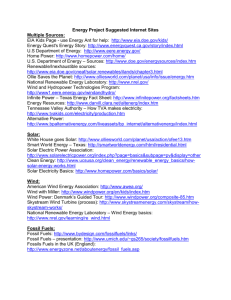What is Nanoscience?
advertisement
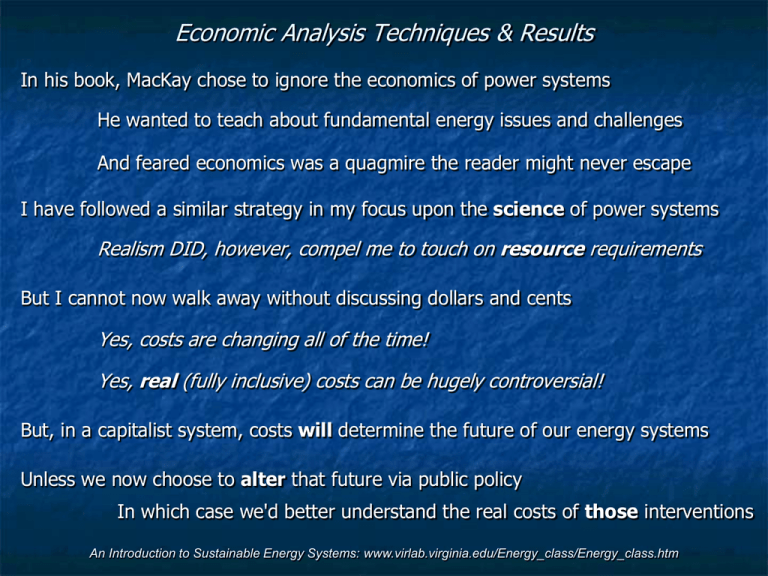
Economic Analysis Techniques & Results
In his book, MacKay chose to ignore the economics of power systems
He wanted to teach about fundamental energy issues and challenges
And feared economics was a quagmire the reader might never escape
I have followed a similar strategy in my focus upon the science of power systems
Realism DID, however, compel me to touch on resource requirements
But I cannot now walk away without discussing dollars and cents
Yes, costs are changing all of the time!
Yes, real (fully inclusive) costs can be hugely controversial!
But, in a capitalist system, costs will determine the future of our energy systems
Unless we now choose to alter that future via public policy
In which case we'd better understand the real costs of those interventions
An Introduction to Sustainable Energy Systems: www.virlab.virginia.edu/Energy_class/Energy_class.htm
Figuring out the purchase price of a power plant:
It should be simple to find the cost of a power plant of type X and capacity Y
At least it should be simple for well established technologies
Such as coal, gas, hydro, or nuclear power plants
After all, we've already built hundreds or even thousands of these!
Further, these were mostly built by public and/or government-regulated companies
So that data, at least, should be readily available, right? WRONG!
Regulated or not, these companies keep their costs analyses very private!
And, for emerging technologies, even secret analyses probably disagree
Given the well known disparities in advocate's public cost claims!
And this is just the starting (purchase price / capital cost) of the power plant!
An Introduction to Sustainable Energy Systems: www.virlab.virginia.edu/Energy_class/Energy_class.htm
Complete comparative data are generated in certain reports
Most of which are published by governmental agencies
Such as the U.S. Energy Information Agency ("EIA")
Which have the advantage of being ~ unbiased about competing technologies
Possibly offset by their naiveté about certain new technologies
(a point I will return to late in this lecture)
But these reports state costs in strange ways, using strange terms such as
Net Present Value
OR Overnight Capital Cost OR O&M Cost
OR, most importantly, whole categories of Levelized Costs
To make sense of these terms and data, we need to learn a bit of . . .
An Introduction to Sustainable Energy Systems: www.virlab.virginia.edu/Energy_class/Energy_class.htm
"Engineering Economics"
Concept #1 - The Time Value of Money:
Which encapsulates the investor's view of what his/her money is really worth
Present value = P = How much money that investor has right now
Future value = F = What investor expects that money to be worth in the future
Which will be greater, because investor expects money to earn interest
To be paid by whomever he/she loans/invests that money to/with
F = P + cumulative interest earnings up to that future date
If annual interest rate is i, the future value of that money will become:
Future value at end of year 1 = P (1 + i)
Future value at end of year 2 = [P (1 + i)](1+i)
Future value at end year n: F(at n) = P(1+i)n
An Introduction to Sustainable Energy Systems: www.virlab.virginia.edu/Energy_class/Energy_class.htm
(1)
Engineering Economics continued:
Concept #2 - Uniform Series Payment:
Which addresses the repayment of a loan or income from a loan/investment
Common way distributing repayments is by uniform amount repaid each interval
Where interval may be once a year, or once a month
Which is exactly what you do with home mortgage or auto loan
We will work out this series by computing payments interval by interval
Accounting for investor's expectation of interest income
That income is usually expressed as an annual percentage interest rate ("APR")
Whereas payment intervals are usually months
in which case interest per month can be taken as = APR / 12
An Introduction to Sustainable Energy Systems: www.virlab.virginia.edu/Energy_class/Energy_class.htm
Working out a uniform series of payments:
Assume a payment of U per payment interval (on a loan/investment of P):
Working out entries for the end of each payment interval:
Interval:
Owed:
Paid:
Now owed (= Owed – Paid)
1
P (1+i)
U
P (1+i) – U
2
[P(1+i) – U] (1+i)
U
[P(1+i) – U] (1+i) - U
3
{P(1+i) – U](1+i) – U} (1+i) U
n
{P(1+i) – U](1+i) – U} (1+i) - U
P(1+i)n – U Σ
j=0
to n
(1+i)j
Now say that U is chosen such that loan is to be paid off at that nth payment:
So "now owed" must then be zero: P(1+i)n = U Σ
j=0
to n
(1+i)j
Which, after some clever algebra, gives: U = P { i / [1 – (1+i)-n] }
(2)
An Introduction to Sustainable Energy Systems: www.virlab.virginia.edu/Energy_class/Energy_class.htm
Playing a bit with these two relationships:
First relationship converted present value (of money) into its value at a future date
Future value (after n time intervals) = Present Value (1+i)n
OR:
F/P (i, n) = (1+i)n where "F/P" is the name of the conversion function
Reverse conversion function is then P/F (i, n)= (1+i)-n
Second relationship took present value (of loan) and converted to series of payments
Uniform Payments (over n time intervals) = Loan { i / [1 – (1+i)-n] }
OR:
U/P (i, n) = i / [1 – (1+i)-n] where "U/P" is name of conversion function
Reverse conversion function is then P/U (i, n) = [1 – (1+i)-n] / i
Expressing these as conversion functions can do two things:
Help you remember/see what a given calculation is really doing AND
Save computing because they're in textbooks (and at end of this lecture)!
Let's now apply this to compute a Levelized Cost:
Over power plant lifetime, there will be series of expenses => Cash Flow Diagram
Year
Annual Costs (fuel, labor, maintenance . . .)
Decomissioning
Cost
Capital Cost
To figure out price to be charged for power, need to know "Levelized Cost" per year
Computation requires two steps, each answering a question:
1) "How much money would I need up front to eventually meet those expenses?"
2) "If you loaned me that money now, what would I need to pay back each year?"
An Introduction to Sustainable Energy Systems: www.virlab.virginia.edu/Energy_class/Energy_class.htm
Choose some values for our power plant calculation:
Our hypothetical power plant:
Capital cost:
1000 M$
Operating lifetime:
10 years
Annual costs (inaccurately lumped together):
10 M$
Decommissioning cost
100 M$
Inaccurately assuming plant is built overnight and decommissioned in 1.0 years:
0
1
2
3
4
5
6
7
9
8
10
11
Year
Annual Operating Costs = 10 M$
Decomissioning Cost = 100 M$
Capital Cost = 1000 M$
Step 1) Money needed up front = Present Values of all costs:
0
1
2
3
4
5
6
7
9
8
10
11
Year
Annual Operating Costs = 10 M$
Decomissioning Cost = 100 M$
Capital Cost = 1000 M$
a) Present Value of Capital Cost: Pcapital = 1000 M$
No conversion is necessary! Because it's a cost right now, at time = 0
b) Present Value of Decomissioning Cost comes from its Future Value:
Conversion function is P/F (10%, 11 yrs) = 1 / (1+0.10)11 = 0.3504 =>
Pdecomissioning = 100 M$ x P/F (10%, 11 yrs) = 35.04 M$
Plus Present Value of all those annual costs:
0
1
2
3
4
5
6
7
9
8
10
11
Year
Annual Operating Costs = 10 M$
Decomissioning Cost = 100 M$
Capital Cost = 1000 M$
c) Present Value of Annual Operating Costs:
String of payments ~ Uniform Payment Series with U = 10 M$
Convert this to the Present Value (of the corresponding loan/investment) with:
P/U (i=10% = 0.1, n=10 yrs) = [1 – (1+0.1)-10] / 0.01
From textbook (or my tables at end of this lecture) P/U (10 yrs, 10%) = 6.1446,
Poperating costs = 10 M$ x P/U (10%, 10 yrs) = 61.446 M$
An Introduction to Sustainable Energy Systems: www.virlab.virginia.edu/Energy_class/Energy_class.htm
Completed "Net Present Value" calculation:
0
1
2
3
4
5
6
7
9
8
10
11
Year
Annual Operating Costs = 10 M$
Decomissioning Cost = 100 M$
Capital Cost = 1000 M$
Net Present Value of the above total cash flow = Sum of present values:
NPV
= Pcapital cost + Poperating costs + Psalvage costs
= 1000 M$ + 10 M$ P/U (10%, 10yrs) + 100 M$ P/F (10%, 11 yrs)
= 1000 M$ + 10 M$ (6.1446) + 100 M$ (0.3504)
= 1000 M$ + 61.44 M$ + 35.04 M$ = 1096.48 M$
Compare to simple sum of costs (which ignores the "time value of money"):
Simple Sum of Costs = 1000 M$ + 10 x 10 M$ + 100 M$ = 1200 M$
Step 2) Annual cost of loan to cover that up front cost
0
1
2
3
4
5
6
7
8
9
10
11
Year
Loan payments?
Up front cost = NPV = 1096.48 M$
Uniform Payment Series of payments you'd now have to pay for n years:
U = P { i / [1 – (1+i)-n] } => NPV x U/P (n, i)
For a 10 year loan at the same 10% interest rate:
U = 1096.48 M$ x U/P (10%, 10 yrs) = 1096.48 M$ x (0.1627)
= 178.39 M$ / year (totaling 1783 million over the life of the mortgage)
THIS is money you have to recoup through your annual power sales
Divided by plant's annual energy output => Levelized Cost of Energy
Schematic of entire Levelized Cost of Energy (LCOE) calculation:
Start with Cash Flow:
Convert all costs to Present Values, adding to get Net Present Value
NPV = 1096.48 M$
Convert NPV to corresponding Uniform Series Payment => Levelized Cost
LCOE = 178.39 M$
NPV = 1096.48 M$
Hold it, why not just pay annual costs from annual income?
1) Then take only ONE loan to cover the capital cost (10 year / 1000 M$ loan):
Annual payment on that loan for power plant's capital expense
Ucapital = U/P (10 year, 10%) x 1000 M$ = (0.1627) x 1000 M$ = 162.7 M$
2) And, each year, put away part of annual income to cover decomissioning cost:
Udecomissioning = U/P (10 year, 10%) x 100 M$ = (0.1627) x 100 M$ = 16.27 M$
3) Plus your annual operating cost (in real time) of 10 M$
Giving you a total annual cost of: 162.7 + 16.27 + 10 M$ = 193.97 / year
Versus previous LCOE financing scheme of 178.39 M$ / year
Strange backward / forward LCOE financing scheme DOES make sense!
Real levelized costs of electrical energy:
Earliest data I found were from the U.S. Congressional Research Service
Which, in 2008, reported these data (which I've entered into an Excel table):
Why did I flag some entries in red? Because I believe they are in error
Source: CRS Report to Congress – "Power Plants: Characteristics and Costs" (November 13, 2008) - Order Code RL34746
Shortcomings of CRS Report:
Quite reasonably, CRS chose to use only data on power plants existing in 2007
To cut through all of the controversy, speculation, exaggeration . . .
Shortcoming of that strategy:
- In 2007 there were already a huge number of coal, hydro, nuclear plants
- But there were very few new, green, sustainable plants
And the few that existed were mostly small-scale, prototype plants
Prime example: This report's data on "existing" solar voltaic power was
based on SINGLE PV installation at Air Force base out in Nevada desert
This base (Nellis AFB) decided to build their own independent power plant
Using new, immature, highly expensive PV
But CRS was right: This WAS THEN the largest U.S. PV power plant!
So bearing this shortcoming in mind:
Let's examine data while realizing that new "tech data" values are questionable
Observation #1) Simple (dirty) coal and gas plants produce ~ cheapest power
Observation #2) Renewable plants (in 2007) had tiny power production capacities
Score for dirty fossil fuels: 2 to Nothing!
So we've got to get more realistic/modern data on alternatives
Enter the U.S. Energy Information Agency ("EIA") which issues:
A yearly: Annual Energy Outlook
With a sub-report: Levelized Cost of New Generation Resources
The latter sub-reports are particularly relevant to this lecture
I've found (and downloaded) these sub-reports for 2011 to present
They support the "Outlook" by estimating costs of power plants initiated today
Which, given licensing and construction times, take years to build
So this year's report is for new power plants coming on line 5 years from now
And, as focus of these reports is on economics (and not on technology)
All costs given are LEVELIZED COSTS
Using the same methodologies that we covered above
Comparing CRS report data with EIA data for new power plants
These 2015 EIA data are projections for new plants coming on line in 2020
Note how these data differ from earlier CRS Report, especially on Solar:
Did CRS switch PV
with Solar thermal?
EIA usefully breaks down its levelized cost estimates:
(RED = particularly bad / high values
GREEN = particularly low / good values)
An Introduction to Sustainable Energy Systems: www.virlab.virginia.edu/Energy_class/Energy_class.htm
Analyzing contributors to EIA total levelized cost, line by line:
Fuel & Variable Operating Costs (costs varying with the plant's output):
"Renewables" have zero to low costs (because nature provides the fuel!)
EXCEPT for BIOMASS which does rack up substantial total fuel cost
Because farmers aren't dumb, they're going to charge for their garbage!
Fixed operating costs:
Fixed Operating Costs:
Solar Thermal has unusually high fixed operating costs
Likely due to complexity:
1000's of steerable mirrors + boiler + turbine + generator
Capital and transmission investment costs:
Capital Cost = THE MAJOR COST for almost every single technology
Exception? Natural Gas = gas powered jet engine connected to generator
Transmission Investment ~ Cost of wiring generators together within a "farm"
E.G. The wiring to be done between solar cells, wind turbines . . .
Capacity factors:
Capacity Factor = Typical plant output / maximum possible output:
LOW for almost all of the renewables
Because the sun doesn't shine nor the winds blow all day
And water reservoirs run low in the summer
High biomass number refers only to plant that burns biomass (not produces it)
OK, but aren't costs of renewables falling?
That is certainly what we are being told!
Can we find indications of this by comparing EIA annual reports?
Where changes might represent falling costs OR:
Represent EIA developing more accurate data for new technologies
Let me first just give you all of the data, then I'll come back and analyze it:
(hoping that I can correctly transcribe all of it from the EIA reports)
An Introduction to Sustainable Energy Systems: www.virlab.virginia.edu/Energy_class/Energy_class.htm
2011 EIA report on Levelized Cost of New Generation Resources
Which predicts costs of power plants coming on line in 2016:
An Introduction to Sustainable Energy Systems: www.virlab.virginia.edu/Energy_class/Energy_class.htm
2012 EIA report on Levelized Cost of New Generation Resources
Which predicts costs of power plants coming on line in 2017:
An Introduction to Sustainable Energy Systems: www.virlab.virginia.edu/Energy_class/Energy_class.htm
2013 EIA report on Levelized Cost of New Generation Resources
Which predicts costs of power plants coming on line in 2018:
An Introduction to Sustainable Energy Systems: www.virlab.virginia.edu/Energy_class/Energy_class.htm
2014 EIA report on Levelized Cost of New Generation Resources
Which predicts costs of power plants coming on line in 2019:
An Introduction to Sustainable Energy Systems: www.virlab.virginia.edu/Energy_class/Energy_class.htm
2015 EIA report on Levelized Cost of New Generation Resources
Which predicts costs of power plants coming on line in 2020:
An Introduction to Sustainable Energy Systems: www.virlab.virginia.edu/Energy_class/Energy_class.htm
My comparison of those four years of LCOE reports:
First some quirky observations:
EIA seems to be having a little bit of trouble with offshore wind power:
As evidenced by its temporary disappearance in the 2012 report
EIA seems to be having a lot of trouble with geothermal:
Total System Levelized Cost:
2011
2012
2013
2014
2015
101.7
98.2
89.6
47.4
47.6
Leading me to doubt the validity of ANY of their geothermal data
An Introduction to Sustainable Energy Systems: www.virlab.virginia.edu/Energy_class/Energy_class.htm
Some important trends in capital costs:
Capital costs of natural gas (CC), nuclear, wind, and solar PV are all falling
But cost of offshore wind continues at ~ 2.5 – 3 times that of onshore wind
Confused trend in (or EIA understanding of) solar thermal
And even more confusion with geothermal
Capital costs of advanced and sequestered coal are rising
Some important trends in total costs:
Total costs of natural gas, nuclear, wind, and solar PV are all falling, but again:
Total cost of offshore wind continues at ~ 2.5 times that of onshore wind
Confused trend in (or EIA understanding of) solar thermal
Confusion (or at least an implausible jump) with geothermal
Total costs of natural gas, advanced and sequestered coal are roughly constant
Something that worried me about the EIA reports:
EIA never mentioned what type of solar PV they were referring to
I assumed it would be single crystal silicon solar cells
Which concerned me because high energy UV sunlight can degrade PV's
Single crystal Si is the toughest stuff with lifetime of perhaps ~ 20 years
Polycrystalline Si is a bit less tough and might last ~ 15 years
Really cheap organic material cells may only last few months / years
But levelized costing assumes financing of projects over their whole lifespan
So EIA analysis SHOULD have taken power plant lifetimes into account
I dug and dug, and the ONLY place EIA mentioned lifetime was in a tax section
Where they used a 30 year lifetime for ALL types of power plants
An Introduction to Sustainable Energy Systems: www.virlab.virginia.edu/Energy_class/Energy_class.htm
I couldn't believe they had ignored technology lifetimes
So I wrote Prof. Edward S. Rubin (of Carnegie Melon)
Author of respected "Introduction to Engineering and the Environment"
He confirmed that EIA reports do assume 30 year lifetimes for everything
Despite the likely shorter (and technology specific) lifetimes of solar PV
Despite the fact that nuclear plants are regularly licensed for 40 years of operation
And many are now being re-licensed for 1-2 decades of more use
Despite the fact that commonly assumed lifetime of hydroelectric dams is 100 years
And Hoover Dam is actually showing few signs of ANY aging at 75
So I decided to try and correct the EIA data by taking likely lifetimes into account
An Introduction to Sustainable Energy Systems: www.virlab.virginia.edu/Energy_class/Energy_class.htm
Combining EIA data with earlier tutorial on levelized costs:
For almost all power generation technologies:
Levelized capital cost = 2/3 – 7/8 of TOTAL levelized annual power cost
(With notable exception of natural gas using cheap jet engine turbines)
But levelized annual capital cost = (up front capital cost) x U/P (i interest, n years)
Where, U/P (n, i) = i / [1 – (1+i)-n]
And although EIA used n = 30 years for ALL different types of power plants
As a technologist, I am telling you they should have used values more like:
n
n
n
n
n
~
~
~
~
~
100 years for hydro
40-60 years for nuclear
30 years for coal and possibly gas, wind, geothermal and solar thermal
20 years for silicon single crystal solar PV
10 (or less) "emerging" PV technologies such as organic PV
So to correct EIA data for likely power plant lifetimes:
EIA's levelized capital costs need to be adjusted by factor of:
U/P (actual plant lifetime, i) / U/P (30 year lifetime, i)
And given heavy contribution of capital cost to total cost
Correction almost as large should be applied to total cost of most plants
Need to know EIA's assumed interest rate, which I didn't spot in EIA reports
But elsewhere found data on overnight capital cost of some plants
= capital + labor + materials cost to build a power plant
This present value (P) x U/P (i=?, 30 yrs) should => EIA's levelized capital cost
Found I could fit EIA conversion to levelized capital cost with i = 10-15%
10-15% interest sounds very high, but this is a relatively risky investment:
If goes bust (and they do!) no one may be willing to buy that power plant!
Calculating my proposed correction to EIA data:
Correction factor (using my fitting value of i ~ 12.5%):
U/P (actual plant lifetime, 12.5%) / U/P (30 year lifetime, 12.5%)
= {i / [1 – (1+i)-actual lifetime ]} / {[i / [1 – (1+i)-30]}
= [1 – (1.125)-30 ] / [1 – (1.125)-actual lifetime ]
For which I get these values:
Actual lifetime (years):
10
20
30
40
60
100
Correction factor:
1.402
1.072
1
0.979
0.9716
0.9709
Corrections: Emerging PV 40% higher, Si PV 7% higher, nuclear/hydro 3% lower
Why if 20 year Si PV lasts half as long as 40 year nuclear is difference only 10%?
Won't I have to buy TWO PV plants to match one nuclear plant?
And thus have to double my charges for PV power to break even?
It would mean that IF your investors expected zero interest:
Your mortgage/bond payments cover two things:
- Repayment of the loan (P)
- Interest on remaining loan balance
Tiny interest rate / short loan: Payment ~ all goes into paying down loan
And the remaining balance on that loan drops ~ linearly with time
Finite interest rate / long loan: Payments are initially almost all interest
And, initially, the remaining balance on the loan drops hardly at all!
The latter is the origin of the lament by "homeowners" that:
"I don't really own my home, I just rent it from my bank!"
An Introduction to Sustainable Energy Systems: www.virlab.virginia.edu/Energy_class/Energy_class.htm
As revealed by plot of balance remaining on various loans:
Balance remaining on a loan is:
Balance (i, n = number of loan intervals, m = this loan interval)
= Loan {1 – [(1+i)n – (1+i)m]/[(1+i)n - 1]}
My Excel plot of Balance/Loan vs. m/n (= percentage through the loan lifetime)
Plotted for i = 15%
Homeowners are right: With long loans initial payments are ~ all interest!
Calculating advantage of getting power plants to last longer:
Say there are three different technologies with same capital cost & power output
But Tech10 lasts 10 years, Tech20 last 20 years, Tech40 lasts 40 years
For 40 years of power I'll need 4 Tech10 plants, 2 Tech20 plants or 1 Tech40 plant
Assume will finance each of these with loans lasting plant lifetime, at 12.5% interest
Total cost = (# of loans) x (# payments per loan) x (payment amount)
Giving, for the three different alternatives supplying 40 years of power:
Tech10 Total cost = (4 loans) (10 payments) [ P x U/P(12.5%, 10 yrs)]
Tech20 Total cost = (2 loans) (20 payments) [P x U/P(12.5%, 20 yrs)]
Tech40 Total cost = (1 loan) (40 payments) [P x U/P(12.5%, 40 yrs)]
vs.
vs.
Pulling up U/P uniform payment table
With data highlighted for our 10, 20 or 40 year long 12.5% interest loans
Source: My Excel spreadsheets – as included at the end of this lecture note set
Inserting those ratios of payments/loan amount (U/P):
Tech10 total cost = P x 4 x 10 x U/P(12.5%, 10 yrs) = 40 P x (0.1806) = 7.224 P
Tech20 total cost = P x 2 x 20 x U/P(12.5%, 20 yrs) = 40 P x (0.1381) = 5.524 P
Tech40 total cost = P x 1 x 40 x U/P(12.5%, 40 yrs) = 40 P x (0.1261) = 5.044 P
Non-surprise: 4 short-lived Tech10 plants cost a lot more!
Surprise: 2 Tech20 plants cost only a little more than 1 Tech40 plant
Initial capital cost:
=
Total 40 year cost:
=
THIS is why EIA economists likely didn't worry about plant lifetimes!
Once lifetimes get up to 20 years, capital costs get buried under "cost of money"
(With ALMOST ALL of each payment covering that expense!)
But plant lifetimes are not quite irrelevant:
Lifetimes WILL STILL BE AN ISSUE for shorter-lived technologies
For instance, emerging non-silicon photovoltaics,
with possible plant lifetimes of 10 years or less,
would add 50% or more to levelized cost of power
Long lifetime plant decisions are also affected by "cost of money"
Say your plant will run efficiently for 30 years
But could run (with more fuel and maintenance) for another 10 years
Would it make more sense to finance and operate it for 30 or 40 years?
The answer could well be "30 years"
Because at 30 years ~ same loan payment could buy a new plant
Which, even if identical, would then require less fuel and maintenance
So EIA really didn't mess up!
I overestimated effect of plant lifetimes because:
I didn't account for "Engineering Economics" / "cost of money"
But above analysis raises another question:
Why not just finance a 40 year nuclear plant with a 20 year mortgage?
Your cumulative loan payment costs would be almost halved
For the same cumulative 40 years of power production!
But for first 20 years you'd have loan payments => higher costs / lower profits
This would likely clobber your up front stock price
Because investors demand maximum profit NOW (and not over 40 years!)
(The "invisible hand" of capitalism not working all that well?)
An Introduction to Sustainable Energy Systems: www.virlab.virginia.edu/Energy_class/Energy_class.htm
OK, but many energy insiders still question EIA's accuracy
And their preferred source of LCOE data is often
Lazard's Levelized Cost of Energy Analysis
I've obtained a copy of Lazard's version 8.0 (2014) Report
Which is really more of a brief public summary, running to only 19 pages
This report presents more complex and nuanced data
Which are supported by only minimal explanations (!)
Confirming Lazard's targeting of energy industry insiders
But making it difficult for (we) energy industry outsiders to parse
An Introduction to Sustainable Energy Systems: www.virlab.virginia.edu/Energy_class/Energy_class.htm
Raw Lazard total levelized cost datadata:
For renewables (above blue line):
This table is for non government subsidized costs
But there is a companion table giving costs with such subsidies
Chart is explained only in these brief accompanying footnotes:
An Introduction to Sustainable Energy Systems: www.virlab.virginia.edu/Energy_class/Energy_class.htm
Things I immediately noted:
Lazard cost data are given in bands, some of which are not footnoted
Leading me to assume range is indicative of uncertainty/variability
In other cases, bands are footnoted, e.g. top of IGCC is for 90% sequestration
Diamonds are also given and footnoted as "implied 2017" costs
Representing, I would have thought, their best guess estimates
But in some cases diamonds are outside of bands – what does this mean?
Technology specific observations (from top to bottom of figure):
Solar data are given for both power plant and residential scale installations
Highlighting increasing importance of "distributed generation"
An Introduction to Sustainable Energy Systems: www.virlab.virginia.edu/Energy_class/Energy_class.htm
Technology specific observations (continued):
Solar PV data given for both crystalline Si and thin film (~ polycrystal Si or CdTe)
I know thin film is cheaper to buy, but has shorter lifetime
Identical costing thus suggests Lazard IS taking lifetime into account
Solar thermal entry is for "Solar Thermal with Storage"
Paralleling a (very expensive!) new data category of "Battery Storage"
Likely "Gas peaking" = evening use of expensive fuel in cheap jet engine generators
"IGCC" fuel not explicitly identified
Both coal and natural gas have been used in CC plants
But gasification part of "IG" makes this entry almost certainly about coal
Which is also supported by separate entry for "Gas Combined Cycle"
Another source of LCOE data: Bloomberg / World Energy Council:
These organizations got partnered in 2013 to calculate renewable energy LCOE's
https://www.worldenergy.org/wpcontent/uploads/2013/09/WEC_J1143
_CostofTECHNOLOGIES_021013_W
EB_Final.pdf
Technology specific figures from the Bloomberg / WEC report
Wind:
PV:
Solar Thermal:
Biomass and Waste:
Above costs vary by world region (with U.S. costs typically average to low average)
Most recent EIA vs. Lazard vs. Bloomberg LCOE data:
EIA
Lazard
Coal:
97.7
66-151
Advanced IGCC coal
110.9
102-171
Sequestered IGCC Coal
138.8
171
Natural Gas CC
66.1
61-87
Natural Gas Peaking
Bloomberg
179-230
Hydroelectric
88.9
????
Nuclear
111.4
92-132
Wind - no subsidy (subsidy)
96
37-81 (14-67)
Geothermal - no subsidy (subsidy)
98.2
89-142 (74-140)
Biomass - no subsidy (subsidy)
115.4
87-116 (67-100)
Solar PV
152.7
80 (land) / 210 (sea)
Si crystalline PV- no subsidy (subsidy)
60-86 (46-66)
120 (w/ tracking)
Thin Film PV – no subsidy (subsidy)
60-86 (46-66)
120
118-130 (96-105)
130 (tower w/ storage)
Solar Thermal - no subsidy (subsidy)
242.0
Comparison Takeaways:
For well established power technologies: EIA and Lazard agree well
With EIA's single cost number typically near middle of Lazard's range
Exception: Lazard's higher figure for advanced sequestered coal
Making this already non-cost-competitive technology even worse!
Renewable technology LCOEs: Lazard ~ Bloomberg << EIA
According to Lazard, for many renewables:
- Non-government subsidized costs are often < non-renewable technologies
- Government subsidized costs are often << non-renewable technologies
Even renewable outlier of solar thermal appears almost competitive:
EIA solar thermal: $242 vs. Lazard: $118-130 (unsubsidized)
Lazard reinforces its optimism about renewables with these figures:
An Introduction to Sustainable Energy Systems: www.virlab.virginia.edu/Energy_class/Energy_class.htm
Lazard: Trends in wind and crystal Si PV costs
("LCOE" = levelized cost of energy)
An Introduction to Sustainable Energy Systems: www.virlab.virginia.edu/Energy_class/Energy_class.htm
Why, then, don't we see massive new wind and solar farms?
I suspect the answer lies in the fact that these are costs of power at some time
But not necessarily the costs of power when we most require it
That is, solar energy peaks at noon and not in evening when our demand peaks
So BIG issue is likely storage of renewable power for the hours of delay required
Supported by Lazard for battery energy storage (alone!) of $168 / MWh
Also their separate "solar thermal" vs. "solar thermal + storage" numbers
(Heat is still stored more efficiently/easily than electrical power!)
EIA's disagreement with other sources also undermines confidence in estimates
Likely causing would-be investors in renewable energy to hesitate
Nevertheless, things DO seem to be looking up for renewable alternatives!
Credits / Acknowledgements
Some materials used in this class were developed under a National Science Foundation "Research
Initiation Grant in Engineering Education" (RIGEE).
Other materials, including the "UVA Virtual Lab" science education website, were developed under even
earlier NSF "Course, Curriculum and Laboratory Improvement" (CCLI) and "Nanoscience Undergraduate
Education" (NUE) awards.
This set of notes was authored by John C. Bean who also created all figures not explicitly credited above.
Copyright John C. Bean (2016)
(However, permission is granted for use by individual instructors in non-profit academic institutions)
Note: Tables of U/P, P/U, F/P and P/F follow this slide
An Introduction to Sustainable Energy Systems: www.virlab.virginia.edu/Energy_class/Energy_class.htm
My tables of U/P (i, n):
From my Excel spreadsheet (checked against Rubin's textbook tables):
An Introduction to Sustainable Energy Systems: www.virlab.virginia.edu/Energy_class/Energy_class.htm
My tables of P/U (i, n):
From my Excel spreadsheet (checked against Rubin's textbook tables):
An Introduction to Sustainable Energy Systems: www.virlab.virginia.edu/Energy_class/Energy_class.htm
My tables of F/P (i, n):
From my Excel spreadsheet (checked against Rubin's textbook tables):
An Introduction to Sustainable Energy Systems: www.virlab.virginia.edu/Energy_class/Energy_class.htm
My tables of P/F (i, n):
From my Excel spreadsheet (checked against Rubin's textbook tables):
An Introduction to Sustainable Energy Systems: www.virlab.virginia.edu/Energy_class/Energy_class.htm
